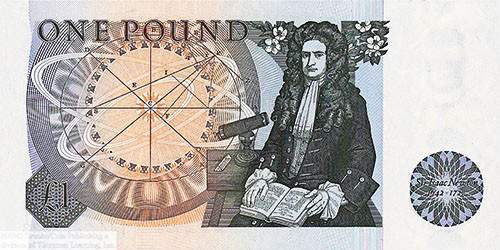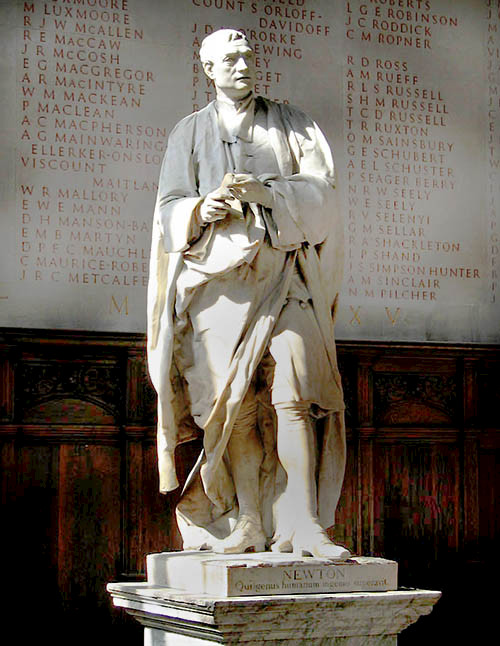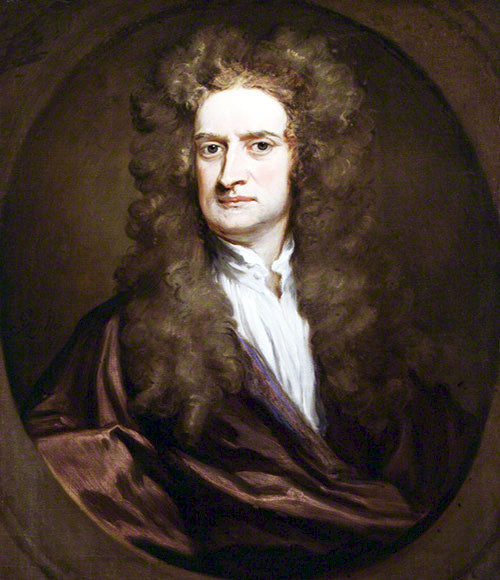Isaac Newton: a solitary genius
Bill Dennison ·‘Scientists who made a difference’ series
Isaac Newton was born in 1642, the same year that Galileo Galilei died. He was born in a modest farmhouse in Woolsthorpe-by-Colsterworth, just north of London. His father died before he was born and his mother remarried when Isaac was three years old and she left him to be cared for by his maternal grandmother. When Isaac was ten years old, his step-father died and his mother moved back with three younger half-siblings. Isaac was sent to a school in Grantham, 8 miles away, and he boarded there until he turned 16 years old. He returned home at his mother's request and attempted farming for a couple of years, but he neither enjoyed nor excelled at farming.

When Isaac was 19, he was rescued by his uncle and a former teacher who convinced his mother to send him to Trinity College at Cambridge University in 1661 where he ended up spending his next 35 years, apart from being exiled to avoid an outbreak of the bubonic plague for a couple of years. Isaac was originally enrolled as a 'subsizar', which meant that he served as a valet to earn his way. He had a limited budget and a limited amount of paper so he developed a shorthand writing style with tiny text which he used throughout his career. Isaac also adopted a standing desk and became renowned for his eccentric habits.
Newton first studied Aristotle and then he purposefully set aside these works and inscribed a quote from Aristotle that read "Plato is my friend, but truth my greater friend." He embarked on what was to become a lifelong quest to develop his own unique natural philosophy of the world. In 1665, an outbreak of the bubonic plague struck London and Newton was summoned home by his mother to avoid this outbreak. Isaac build a study in his family house and proceeded to fill a thousand page notebook with his drawings, writings, mathematical derivations and notes to himself. These notes were the foundation of Newton's important later works. London also suffered a great fire in 1666, so his self-imposed isolation was fortuitous.
In 1667, Newton returned to Cambridge at the age of 24, but at a higher status, as a fellow. As a fellow, he was to adopt a life of chastity and was not permitted to marry. Newton followed this vow for the rest of his life, and likely died a virgin. Newton wrote the following passage about his chastity: "The way to chastity is not to struggle directly with incontinent thoughts but to avert the thoughts by some imployment, or by reading, or meditating on other things.…”

Newton began experimenting with light and studying optics. He even inserted a bodkin (a large blunt needle) into his eye socket to deform his eyeball as an experiment to test the influence of the shape of his eyeball on eyesight. Newton was inspired by a more senior scientist, Robert Hooke, but Hooke was to become Newton's rival.
Newton followed the tradition of early Renaissance scholars like Copernicus, Galileo and Kepler in using and advancing the development of telescopes. Newton's innovation with regard to telescopes capitalized on his knowledge of optics. Newton carefully ground glass into a reflecting lens and invented the first reflecting telescope. His telescope was much shorter than the refractive lens telescopes created previously, yet just as powerful. Newton's friend Isaac Barrow took Newton's telescope to the Royal Society of London, a group of learned men formed in 1662. Based on Barrow's recommendation, Newton was invited to join the Royal Society as a Fellow. He joined the Royal Society, but limited his interactions to written correspondence for three years. These letters to the Royal Society became his first published works and began some vigorous written debates published in the Philosophical Transactions of the Royal Society which served to make others aware of the acute mind that Newton possessed.
In 1675, Newton finally traveled into London to meet some of the scientists he had only met via written correspondence. He maintained a vigorous debate about the nature of light (wave vs. particle), particularly with Robert Hooke. In one of Newton's most famous replies, he wrote "If I have seen further it is by standing on the shoulders of giants." Now in his thirties, Newton had long, unkempt prematurely gray hair, and he stayed in his chamber for days on end, working by candlelight at night. He was the epitome of the absent-minded professor. His book “Philosophie Naturalis Principia Mathematica” was printed by the Royal Society in 1687 and included Newton’s three laws of motion. It was written in Latin and was very dense. His following books were written in English and were more approachable.

One of the aspects of Newton's life that was only discovered after his death was his extensive work in alchemy. He collected an alchemy writings and had a hidden index of his various readings. He built a shed in the garden next to his room and experimented with various metals, attempting to convert them into different forms. Newton would touch, smell, taste and feel the various chemical compounds he created or experimented with. His hair was tested after his death and large amounts of mercury were present, indicating that he may have been slowly poisoning himself. Some of his erratic behavior, particularly near the end of his life could have been influenced by mercury poisoning.
A legend surrounding Newton had to do with his observation of the fall of an apple from an apple tree, sparking Newton's insight into the physics of gravity. There are several candidate apple trees which may have nominated to this exalted status, but it is likely a tree from the orchard near his family home. I have a friend, Alice Newton, who is descended from the Newton family (Isaac did not have any progeny himself, but his siblings and cousins did). Alice actually has an apple pickled in alcohol from his orchard. Newton wrote the following passage about gravity: “It is enough,” he said, “that gravity really exists and acts according to the laws that we have set forth and is sufficient to explain all the motions of the heavenly bodies and of our sea.”

Isaac's long and interesting career included a role as the Warden and then the Master of the Royal Mint. He left Cambridge and moved to London in 1696. Responsible for manufacturing coinage for the British government, Newton also actively pursed counterfeiters. Newton was able to become personally wealthy and amassed a library of over two thousand books.
Newton grew quite wealthy and received many honors during his lifetime and posthumously. He died in 1727. Many books of his writings and biographies exist, including a good biography by James Gleick, Isaac Newton, published in 2003. Newton became President of the Royal Society and was knighted by Queen Anne. When the Russian Tsar Peter the Great visited London, he asked to see a) shipbuilding, b) the Greenwich Observatory, c) the mint and d) Isaac Newton. Newton is buried in Westminster Abbey, under a monument with a statue of him, with a pyramid and a globe. The inscription on his monument by the poet Alexander Pope reads as follows: "Nature and Nature’s laws lay hid in night; God said, Let Newton be! And All was Light."
About the author
Bill Dennison

Dr. Bill Dennison is a Professor of Marine Science and Vice President for Science Application at the University of Maryland Center for Environmental Science.

